
The First Arrivals to America
Not just one, but Multiple Waves of Immigrants from Europe and Asia!
How long ago? This question has belabored archaeologists for as long as explorers
and settlers have encountered the artifacts, mounds and earthworks left behind by the Indians
of long ago. With succeeding advances in technology and science, each new discovery pushes
mankind's arrival in the Americas further and further back in time.
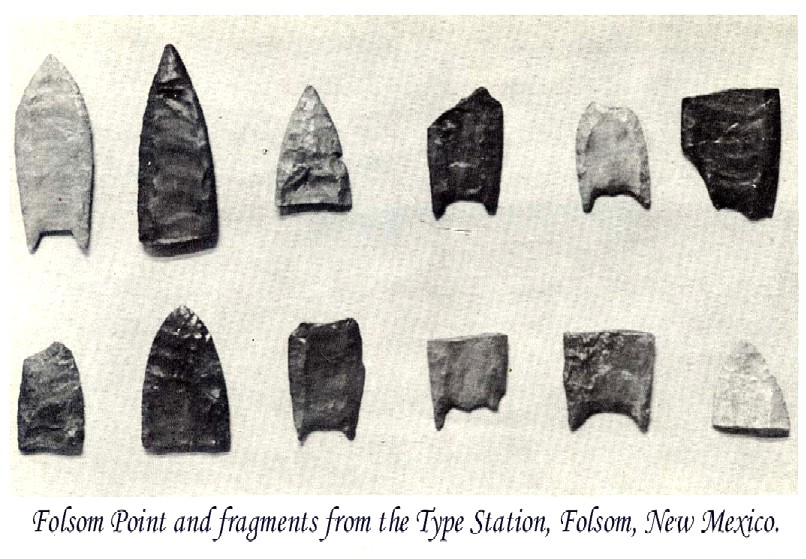
A discovery that was to have far-reaching effects on the course of American anthropology was made in 1926, just 8 miles west of the little town of Folsom, New Mexico. On a small tributary of the Cimarron River, a party of paleontologists from the Colorado Museum of Natural History were excavating the bones of a species of gigantic bison believed long extinct before man's arival here.
Two pieces of chipped flint were found in loose dirt removed from the excavation--but a third piece was uncovered in-situ, embedded in the clay surrounding a rib bone of one of the bison. The whole block-matrix--clay, bone and flint as found, was shipped back to the museum for study. There, it became apparent that one of the previously removed pieces of flint fitted perfectly to the one still embedded in the matrix. The two pieces combined to form part of a readily distinguishable projectile point.
The discovery of man-made artifacts in undeniable context with bones of long-extinct animals in an undisturbed deposit of Pleistocene age suggested of mankind's greater antiquity in the New World--but how long ago was it? Subsequent excavations at the site provided further proofs, and the projectile point was named for the nearby town of Folsom.
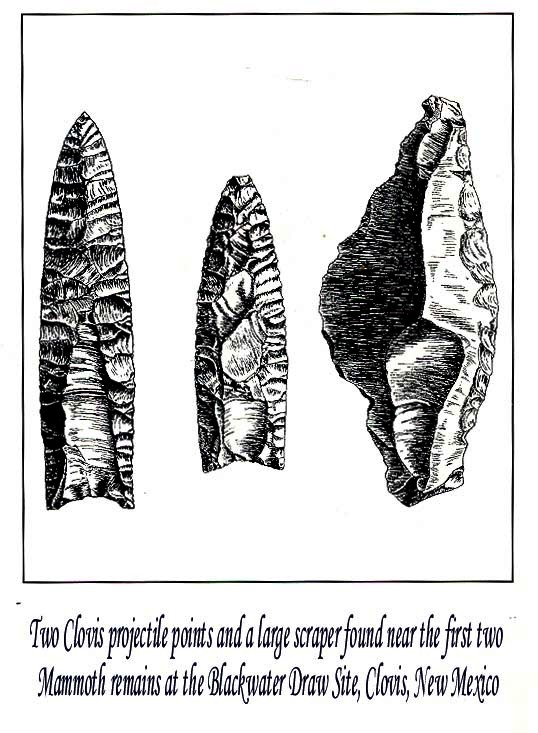
Theorists propose that the Gulf Stream’s warming waters coursing their way northward to the edges of the ice provided an environment suitable for a vast array of wildlife—seals, sea lions and walrus, whales and fish, and numerous shore- and sea-birds that could have been hunted for early man’s survival.
In 1932 a new discovery was made outside the small town of Clovis, New Mexico in a gravel pit being used to furnish roadbed material for the state--one that would eventually prove even older than the previous discoveries in Folsom, NM. Ancient bones were found here, too, and among them bones of extint mammoths were found in association with chipped flint projectile points. Word was sent out to all the nation's great institutions of learning, and the leading scientific minds of the era came to see for themselves the undenaible proof of mankind's presence at the time these great beasts were living.Clovis was given to the style of projectile point found here, after the name of the town nearby.
Back then the primary keys to dating the antiquity of such finds lay in the analysis of the stratigraphic layering of earth which contained the remains. Studies of the geological formations of the region, and of the continent as a whole, offered checks for new discoveries against known, dated deposits. Scientists did not have carbon-14 or thermo-luminescence or other modern techniques to help determine their age in the depression of the '30's. Across the country a great number of discoveries of projectile points in context with bones of extinct animals came to light, establishing sequences of cultures that followed one another through time. Geological formations' ages were matched to campsites' loctions and stratigraphy. As each bit of information and data was acquired, our knowledge of the past grew proportionately. The date when mankind first arrived in this hemisphere, ca. 12,000BC or 14,000 years ago, remained a scientific fixture for many years, but new evidence was mounting for even earlier dates for the crossings to America.

One of the earliest sites undeniably proving man's presence was discovered here in Virginia at the Cactus Hill Site on the Nottoway River in southeastern Virginia. The earliest C14 dating of hearth-charcoal at the site reveals that mankind was here at least 17,000 years ago!
Numerous other sites place later clovis-hunters moving throughout southeastern Virginia, through the identification of and tracking the sources of materials carried away from quarry-sites surrounding several outcroppings of choice lithics. Stone best suited for projectile point making was always prefered over lesser quality materials, and the distribution of lithic materials from known quarries to various Paleoindian camps offers insights into seasonal migration and subsistence strategy patterns.
Current thinking holds that early man could have traveled a route along the edges of the ice sheets covering the north Atlantic during the last ice age.
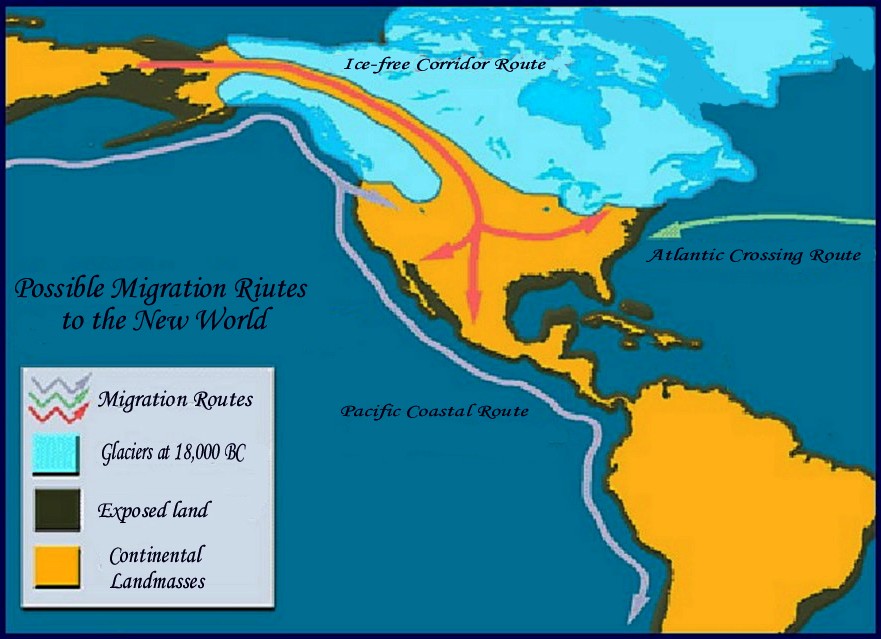
The prospect of ancient travel across wide stretches of open sea has yet eluded hard scientific proof, yet the prospect is tantalizing and imaginatively potent. Such theories as have been offered also push other technologies further back in time—among them a working knowledge of the basics of navigation and an understanding of the stars and celestial phenomenon… It has been duly noted that Australia’s Aborigines arrived to that continent some 40 thousand years ago—by boat… Being no great stretch of the imagination, early man could conceivably have skirted the north Atlantic ice sheets some 20 thousand years later with relative ease.
In addition to these theories is a newly advanced and controversial one, and it hinges upon this:
Strategies whereby stone projectile points are made have been shown to follow an exclusive traditional continuum, that is, the manufacture of any given point was an exercise in systematic blade reduction and flaking techniques used and handed down over perhaps up to hundreds of generations. By defining and analyzing flaking strategies, shared techniques can be discovered, establishing a tentative link between two cultures.
The Solutrean Culture of Spain and France followed such lines of tradition: flake removal at the finishing stages of point-manufacture exhibit a singular trait among the worlds’ lithics technologies—the practice of removing long narrow flakes that extend from one margin of the blade across to the other. This technique is called overshot or outre’ passé flaking.
In following the evidence of sequential flake removal in the manufacture of projectile points of the Solutrean Culture, flint knapping experts have discovered that there is but one other culture the world over that practiced this outre’ passé flaking tradition—the Clovis Culture. The uniqueness of this flaking strategy cannot be overstated here—it is found nowhere else in the entire world of aboriginal flint knapping, nowhere except in both the Solutrean and Clovis cultures…with Clovis here succeeding Solutrean in europe.
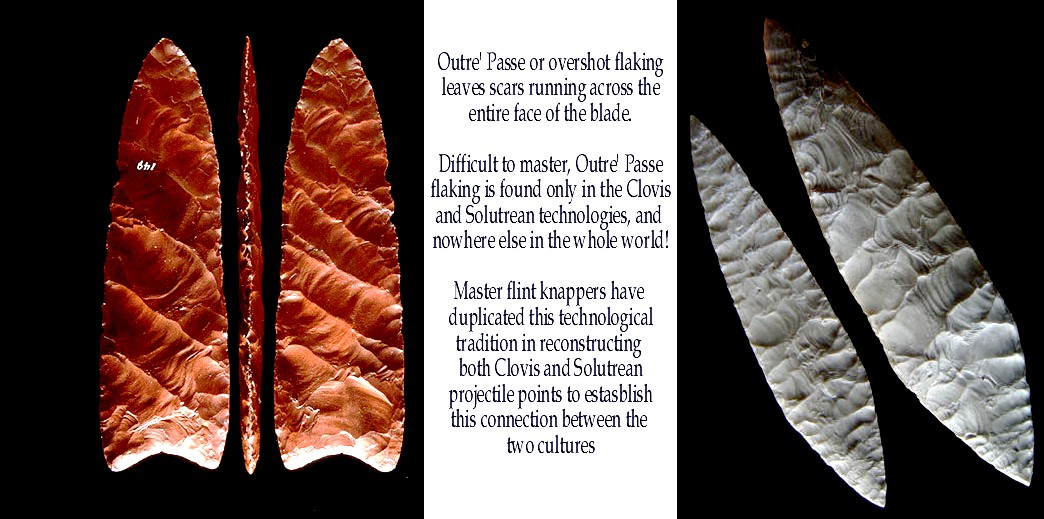
Additional circumstantial evidence comes in the way of Clovis camp-, hunting- and quarry-sites themselves. Recognized sites across the continent have furnished many details of Clovis culture, including the development of sub-variants of the basic Clovis projectile point that reflect evolving diversity among distant groups of Clovis peoples. Far more significant in the overall scheme of events is the discovery of a far greater density of sites along the coastal regions of the eastern United States, and primarily along the mid-Atlantic coast and southwards. The shear numbers of eastern sites suggests Clovis owes its origins to a trans-Atlantic culture rather than to those crossing the Bering Straits. As mentioned above, the Cactus Hill Site has provided absolute dates to 17 thousand years ago for man’s inhabitation of eastern Virginia. Similar dates have been determined at other locations, including the famous Meadowcroft Rock Shelter in Pennsylvania, dated to 16 thousand years ago…
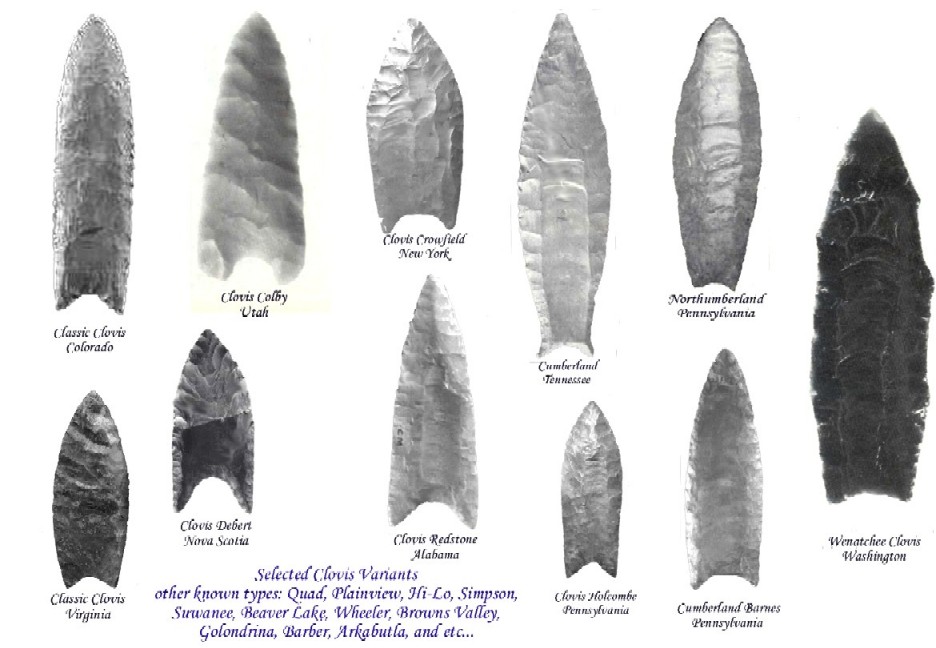
Now, let's not forget the Bering Strait and those who did cross over from Asia--while these immigrants were perhaps not the first peoples to reach America, succeeding waves of immigrants did cross the land-bridge and the icy northern wastes or boated their way around the northern pacific rim along vast kelp beds teaming with marine life, sea mammals and birds. It has been shown that these same kelp beds also act to calm rougher seas, possibly easing the path boats may have taken.
One of the intriguing phenomenon of cultures from the northwest is the numbers of cultures inhabiting seperate but closely meshed micro-niches along the mountainous coastal regions. This, it has been suggested, is evidence of arriving cultures finding themselves backed up into a traffic jam or bottle-neck of sorts, the leading cultures finding themselves somewhat blocked from further advance by an existing culture that had arrived much earlier--the Clovis Hunters. This traffic jam seemingly lasted until the Clovis peoples themselves either were absorbed into other cultural groups when their own culture collapsed, or were turned back and retreated southward, to spread their culture into the central and southern reaches of the continent.
Archaeologists and collectors alike have found numerous individual projectile point technologies whose makers occupied marginal lands amidst other groups, roughly during the same period of time. With the collapse of Clovis culture, many of these heretofore penned-in cultures virtually exploded across the continent, some leaving evidence of their passing most or all the way to the eastern coast of America.
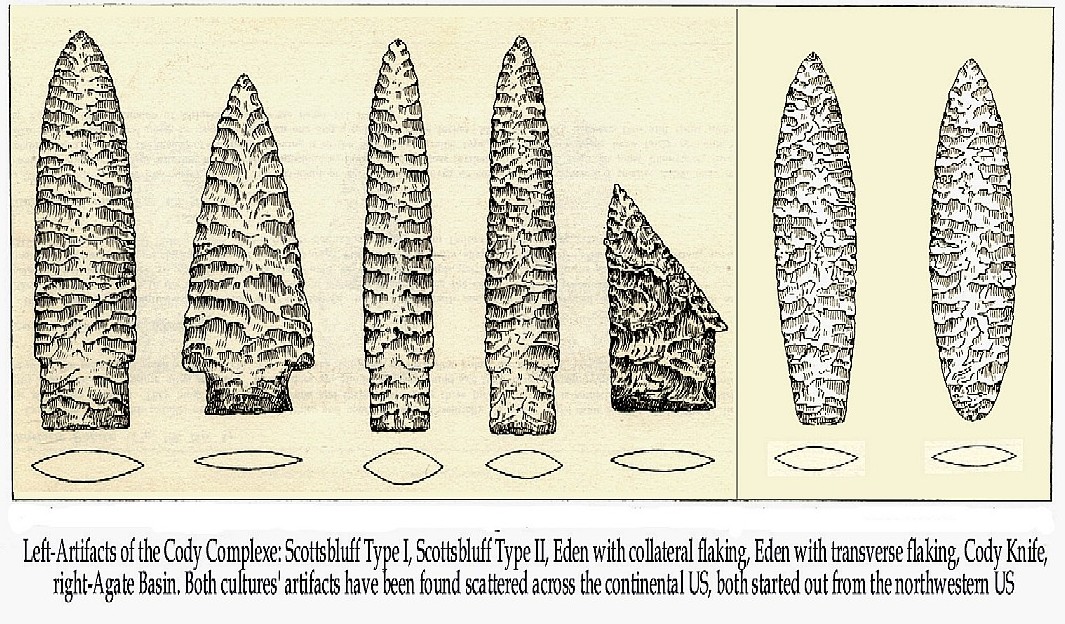
Among them were bison hunters now known as the Cody Complexe, whose distinctive projectile points mark them from other groups--it is by these distinctive projectile points that individual cultures are noted in their march across the continent in search of big game animals. Migrating herds driven by these hunters over canyon cliffs and through narrow arroyos and passes have left piles of fossilized bones that in places reach 40 to 50 feet in depth and more. It is clear that many bison-jumps were used again and again over long periods of time. Among the bones are tell-tale projectile points, cutting and butchering tools of stone--sometimes several cultures utilized the same hunting grounds in turn and turn about, leaving both a record of succeeding hunts and cultural artifacts piled one on top of the other.
Artist Nola Davis' painting of a Bison Kill: Stampeding Bison were chased over a cliff and killed en mass
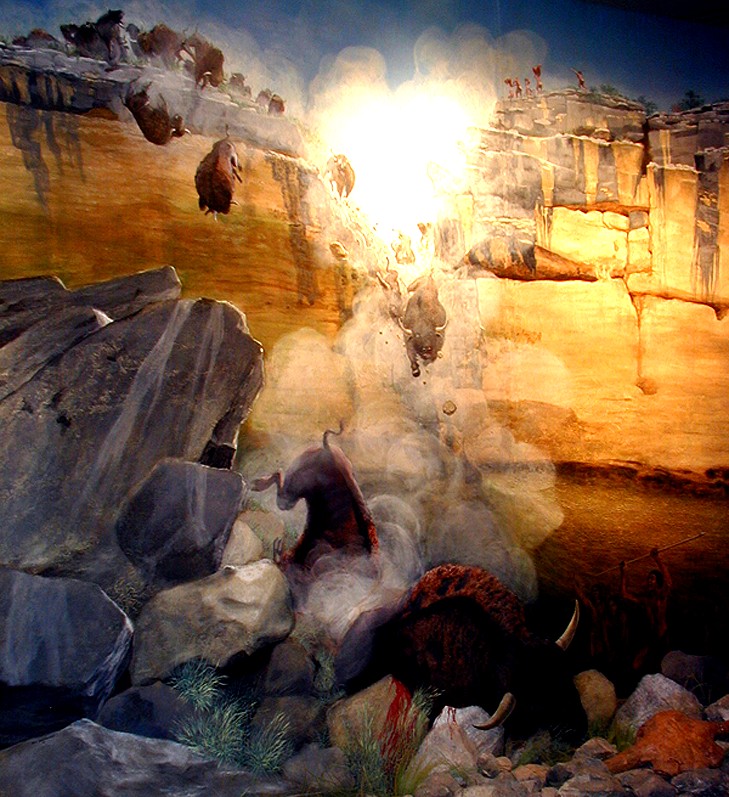
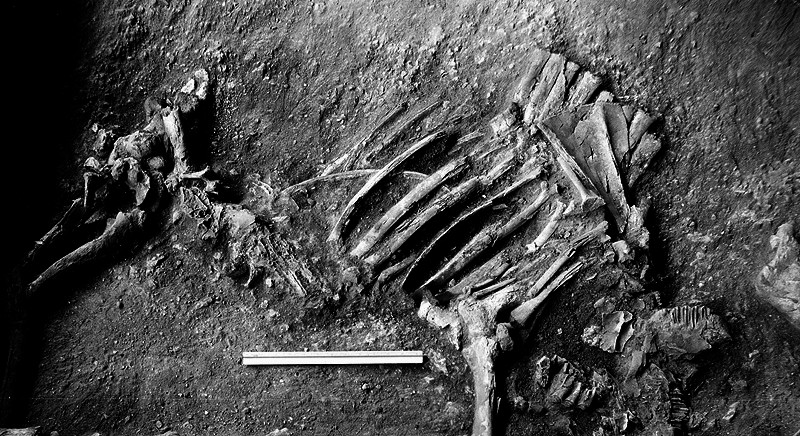
A bison calf discovered left unbutchered under the butchered remains of others